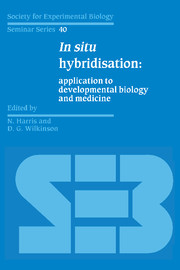Book contents
- Frontmatter
- Contents
- List of contributors
- Preface
- Non-radioisotopic labels for in situ hybridisation histochemistry: a histochemist's view.
- Use of haptenised nucleic acid probes in fluorescent in situ hybridisation
- The use of complementary RNA probes for the identification and localisation of peptide messenger RNA in the diffuse neuroendocrine system
- Contributions of the spatial analysis of gene expression to the study of sea urchin development
- Advantages and limitations of in situ hybridisation as exemplified by the molecular genetic analysis of Drosophila development
- The use of in situ hybridisation to study the localisation of maternal mRNAs during Xenopus oogenesis
- In situ hybridisation in the analysis of genes with potential roles in mouse embryogenesis
- Evolution of algal plastids from eukaryotic endosymbionts
- Localisation of expression of male flower-specific genes from maize by in situ hybridisation
- Tissue preparation techniques for in situ hybridisation studies of storage-protein gene expression during pea seed development
- Investigation of gene expression during plant gametogenesis by in situ hybridisation
- Sexing the human conceptus by in situ hybridisation
- Non-isotopic in situ hybridisation in human pathology
- The demonstration of viral DNA in human tissues by in situ DNA hybridisation
- Index
Contributions of the spatial analysis of gene expression to the study of sea urchin development
Published online by Cambridge University Press: 04 August 2010
- Frontmatter
- Contents
- List of contributors
- Preface
- Non-radioisotopic labels for in situ hybridisation histochemistry: a histochemist's view.
- Use of haptenised nucleic acid probes in fluorescent in situ hybridisation
- The use of complementary RNA probes for the identification and localisation of peptide messenger RNA in the diffuse neuroendocrine system
- Contributions of the spatial analysis of gene expression to the study of sea urchin development
- Advantages and limitations of in situ hybridisation as exemplified by the molecular genetic analysis of Drosophila development
- The use of in situ hybridisation to study the localisation of maternal mRNAs during Xenopus oogenesis
- In situ hybridisation in the analysis of genes with potential roles in mouse embryogenesis
- Evolution of algal plastids from eukaryotic endosymbionts
- Localisation of expression of male flower-specific genes from maize by in situ hybridisation
- Tissue preparation techniques for in situ hybridisation studies of storage-protein gene expression during pea seed development
- Investigation of gene expression during plant gametogenesis by in situ hybridisation
- Sexing the human conceptus by in situ hybridisation
- Non-isotopic in situ hybridisation in human pathology
- The demonstration of viral DNA in human tissues by in situ DNA hybridisation
- Index
Summary
Early motivations
In 1977 we (L. M. A. and R. C. A.) submitted our first research proposal to the National Institutes of Health. The most speculative part was to use in situ hybridisation techniques to determine the distribution of individual mRNAs in sea urchin embryos. We suggested that information on spatial distribution would be useful in approaching three questions. First, we were puzzled that molecular assays of gene expression in whole embryos had led to the generalisation that most mRNAs are found throughout development (reviewed by Davidson, 1976, 1986) and that a relatively small percentage show large changes in abundance on a per embryo basis. The missing information required to interpret these observations was the extent to which genes are spatially regulated in different tissues or lineages. Second, we hoped to identify sets of mRNAs whose expression is co-ordinated in time and space, so that the mechanism of that co-ordination could be investigated. Third, we suggested that individual spatially restricted mRNAs could serve as molecular markers to construct a fate map of the embryo, to determine when cells commit to specific patterns of gene expression, and possibly to identify maternal RNAs localised in the egg. We proposed a longterm commitment to ‘localise the time and site of synthesis of individual mRNA species in developing embryos’. A dozen years seems an appropriately long time, and we take this opportunity to review the contribution of information gained from in situ hybridisation studies to the questions we initially anticipated, as well as to some we did not.
- Type
- Chapter
- Information
- In Situ HybridisationApplication to Developmental Biology and Medicine, pp. 69 - 96Publisher: Cambridge University PressPrint publication year: 1990
- 3
- Cited by



